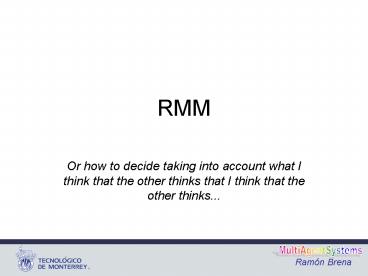RMM PowerPoint PPT Presentation
Title: RMM
1
RMM
- Or how to decide taking into account what I think
that the other thinks that I think that the other
thinks...
2
Multiagent Rational Decisions
- Without other rational agents
- With other rational agents
- Game Theory equilibria
- Recursive Decision Analysis
3
Utility matrices
4
Example.- Observation Robots
5
Possible actions
- a11 R1 goes to P1
- a12 R1 goes to P2
- a13 R1 does nothing
- a21 R2 goes to P1
- a22 R2 goes to P2
- a23 R2 does nothing
6
Utility matrix calculation
7
Utility matrix calculation
8
What will R2 do?Case 1.- R2 knows about P2
9
What will R2 do?Case 1.- R2 knows about P2
10
Case 2.- R2 does not know about P2
11
Case 2.- R2 does not know about P2
12
Probabilities
P0.9
P0.1
13
Model nesting
- ...but R2 needs to know what R1 thinks in order
to make a rational decision. - This could continue indefinitely
- At some point recursive mutual knowledge ends.
- No-info nodes
14
(No Transcript)
15
No-infos
- No-info2 indicates that R1 knows R2 does not have
knowledge to model R1 - No-info1 represents lack of knowledge in R1 about
whether it is being modeled by R2 or how. - No-info could be considered as a uniform
probability distribution over actions.
16
Solving the decision problem
- We proceed bottom-up
- First we calculate the expected utility of
subtrees, then the utility of nodes. - Process ends when root is reached.
17
Leaves calculation
- If R2 does not know about P2, R2 expected
utilities are - u(a21) 0.50 0.50 0
- u(a23) 0.52 0.50 1 (wins)
- If R2 could see P2, its utilities are
- u(a21) 0.330 0.334 0.330 1.33
- u(a22) 0.335 0.333 0.333 3.67 (wins)
- u(a23) 0.332 0.334 0.330 2
18
Reconsidering R2
- With probability p 0.9 decides a23 (do
nothing) - With probability p 0.1 decides a22 (go to P2)
- So with probability p 0 decides a21 (go to P1)
19
Upwards propagation
- Utilities of R1 actions are
- u(a11) 01 0.15 0.91 1.4
- u(a12) 04 0.12 0.92 2
- u(a13) 02 0.14 0.90 0.4
- We conclude that R1 decides to go to P2
- R1 believes it is so unlikely that R2 goes to P2,
that it better goes itself.
20
Comparison with Game Theory
- Game Theory equilibria search does not apply
because there is no common knowledge - (R1 does not know if R2 knows what R1 knows about
P2, etc).
PowerShow.com is a leading presentation sharing website. It has millions of presentations already uploaded and available with 1,000s more being uploaded by its users every day. Whatever your area of interest, here you’ll be able to find and view presentations you’ll love and possibly download. And, best of all, it is completely free and easy to use.
You might even have a presentation you’d like to share with others. If so, just upload it to PowerShow.com. We’ll convert it to an HTML5 slideshow that includes all the media types you’ve already added: audio, video, music, pictures, animations and transition effects. Then you can share it with your target audience as well as PowerShow.com’s millions of monthly visitors. And, again, it’s all free.
About the Developers
PowerShow.com is brought to you by CrystalGraphics, the award-winning developer and market-leading publisher of rich-media enhancement products for presentations. Our product offerings include millions of PowerPoint templates, diagrams, animated 3D characters and more.

